Material Science in Construction: Concrete Defect Analysis Report
VerifiedAdded on 2023/06/12
|8
|1732
|68
Report
AI Summary
This report investigates a construction material defect within the Sydney region, focusing on concrete. It details the properties of concrete, its functions in construction (including durability, strength, and fire/flood resistance), and a specific defect: honeycomb. The report describes honeycomb defects as hollow cavities caused by mortar not filling voids between coarse aggregate particles, and discusses the causes such as coarse aggregates, improper vibration, and incorrect water-cement ratio. It outlines a solution involving removing loose concrete, applying a mechanical injection pressure pump with non-shrink epoxy grout, and using repair mortar. The report concludes by summarizing the investigation, emphasizing the importance of understanding material properties and addressing defects to maintain structural integrity.
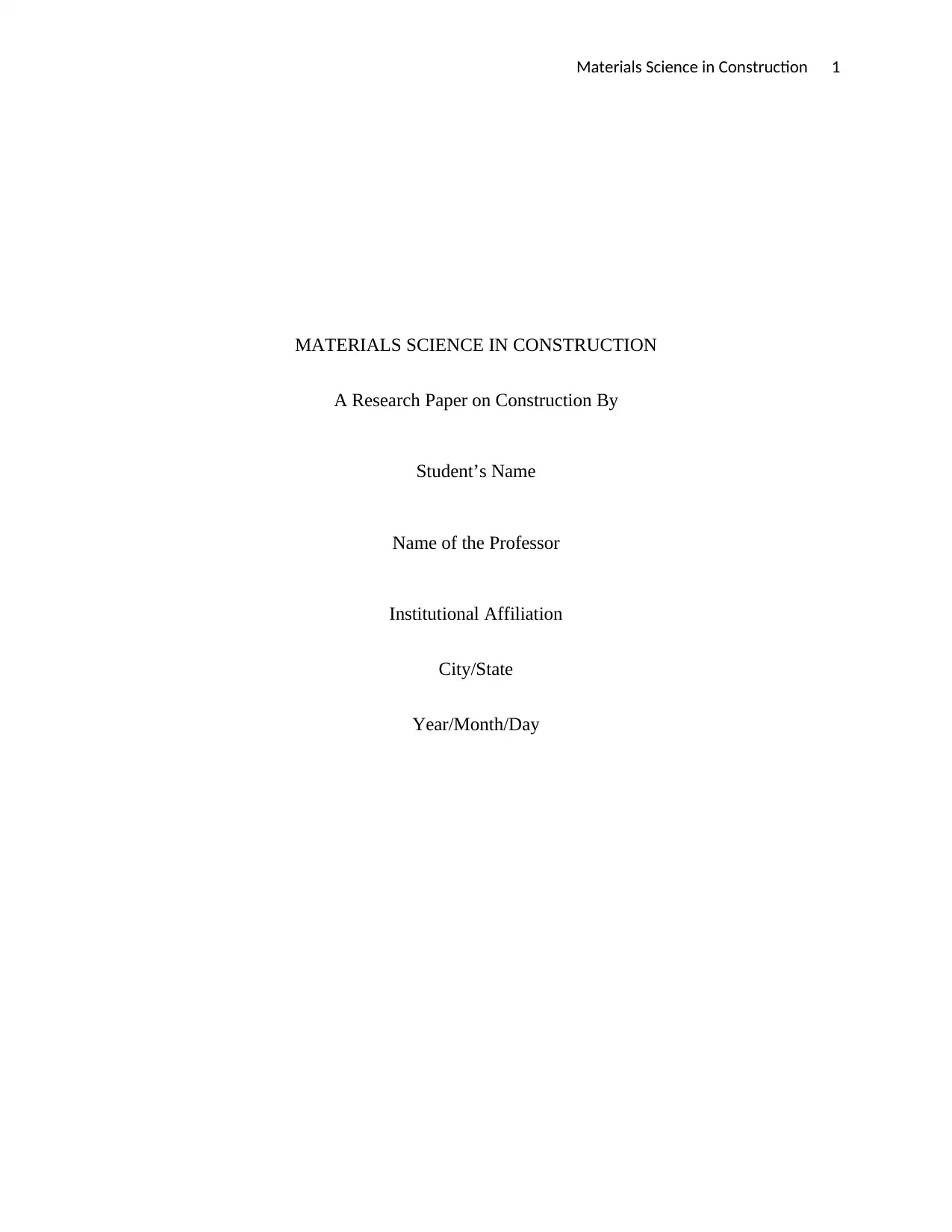
Materials Science in Construction 1
MATERIALS SCIENCE IN CONSTRUCTION
A Research Paper on Construction By
Student’s Name
Name of the Professor
Institutional Affiliation
City/State
Year/Month/Day
MATERIALS SCIENCE IN CONSTRUCTION
A Research Paper on Construction By
Student’s Name
Name of the Professor
Institutional Affiliation
City/State
Year/Month/Day
Paraphrase This Document
Need a fresh take? Get an instant paraphrase of this document with our AI Paraphraser
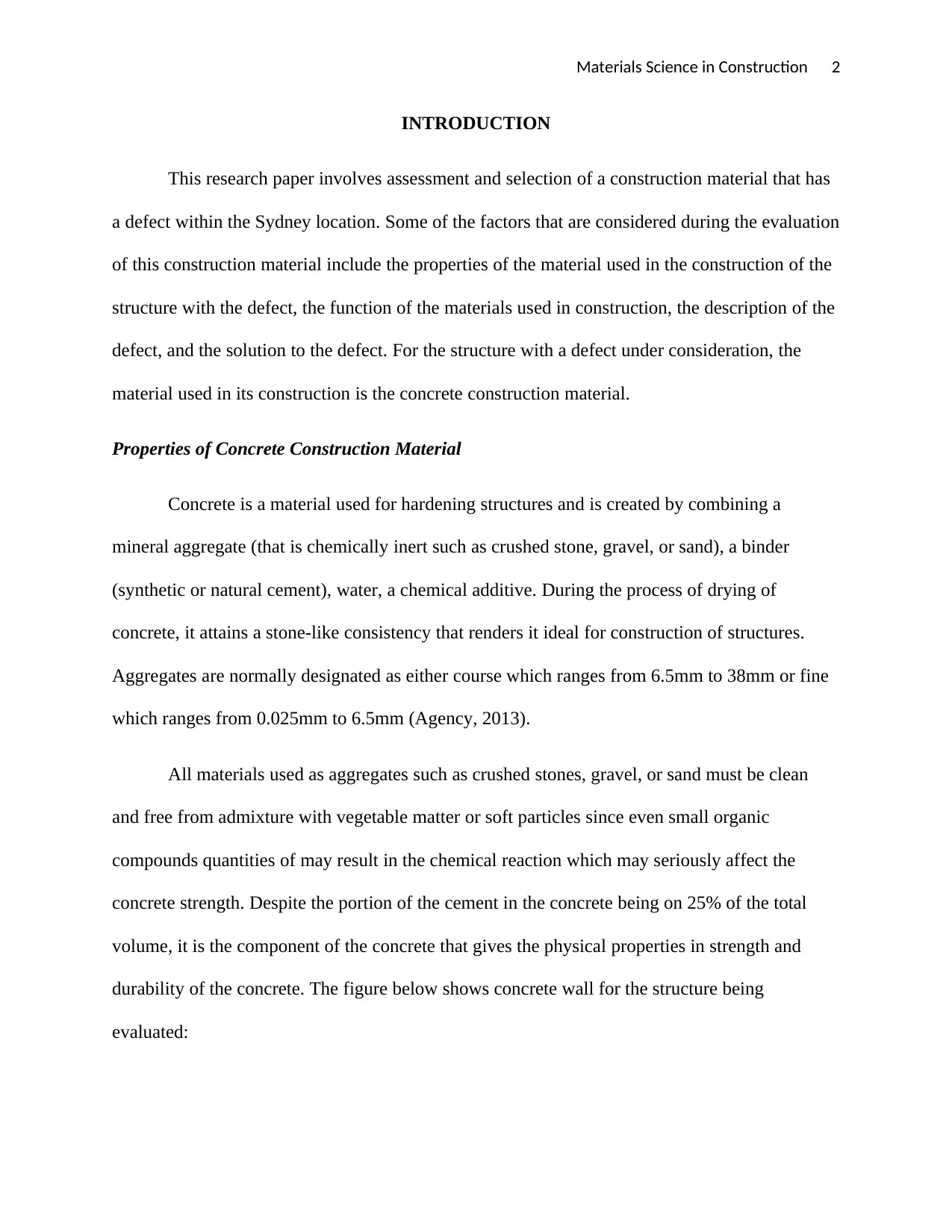
Materials Science in Construction 2
INTRODUCTION
This research paper involves assessment and selection of a construction material that has
a defect within the Sydney location. Some of the factors that are considered during the evaluation
of this construction material include the properties of the material used in the construction of the
structure with the defect, the function of the materials used in construction, the description of the
defect, and the solution to the defect. For the structure with a defect under consideration, the
material used in its construction is the concrete construction material.
Properties of Concrete Construction Material
Concrete is a material used for hardening structures and is created by combining a
mineral aggregate (that is chemically inert such as crushed stone, gravel, or sand), a binder
(synthetic or natural cement), water, a chemical additive. During the process of drying of
concrete, it attains a stone-like consistency that renders it ideal for construction of structures.
Aggregates are normally designated as either course which ranges from 6.5mm to 38mm or fine
which ranges from 0.025mm to 6.5mm (Agency, 2013).
All materials used as aggregates such as crushed stones, gravel, or sand must be clean
and free from admixture with vegetable matter or soft particles since even small organic
compounds quantities of may result in the chemical reaction which may seriously affect the
concrete strength. Despite the portion of the cement in the concrete being on 25% of the total
volume, it is the component of the concrete that gives the physical properties in strength and
durability of the concrete. The figure below shows concrete wall for the structure being
evaluated:
INTRODUCTION
This research paper involves assessment and selection of a construction material that has
a defect within the Sydney location. Some of the factors that are considered during the evaluation
of this construction material include the properties of the material used in the construction of the
structure with the defect, the function of the materials used in construction, the description of the
defect, and the solution to the defect. For the structure with a defect under consideration, the
material used in its construction is the concrete construction material.
Properties of Concrete Construction Material
Concrete is a material used for hardening structures and is created by combining a
mineral aggregate (that is chemically inert such as crushed stone, gravel, or sand), a binder
(synthetic or natural cement), water, a chemical additive. During the process of drying of
concrete, it attains a stone-like consistency that renders it ideal for construction of structures.
Aggregates are normally designated as either course which ranges from 6.5mm to 38mm or fine
which ranges from 0.025mm to 6.5mm (Agency, 2013).
All materials used as aggregates such as crushed stones, gravel, or sand must be clean
and free from admixture with vegetable matter or soft particles since even small organic
compounds quantities of may result in the chemical reaction which may seriously affect the
concrete strength. Despite the portion of the cement in the concrete being on 25% of the total
volume, it is the component of the concrete that gives the physical properties in strength and
durability of the concrete. The figure below shows concrete wall for the structure being
evaluated:
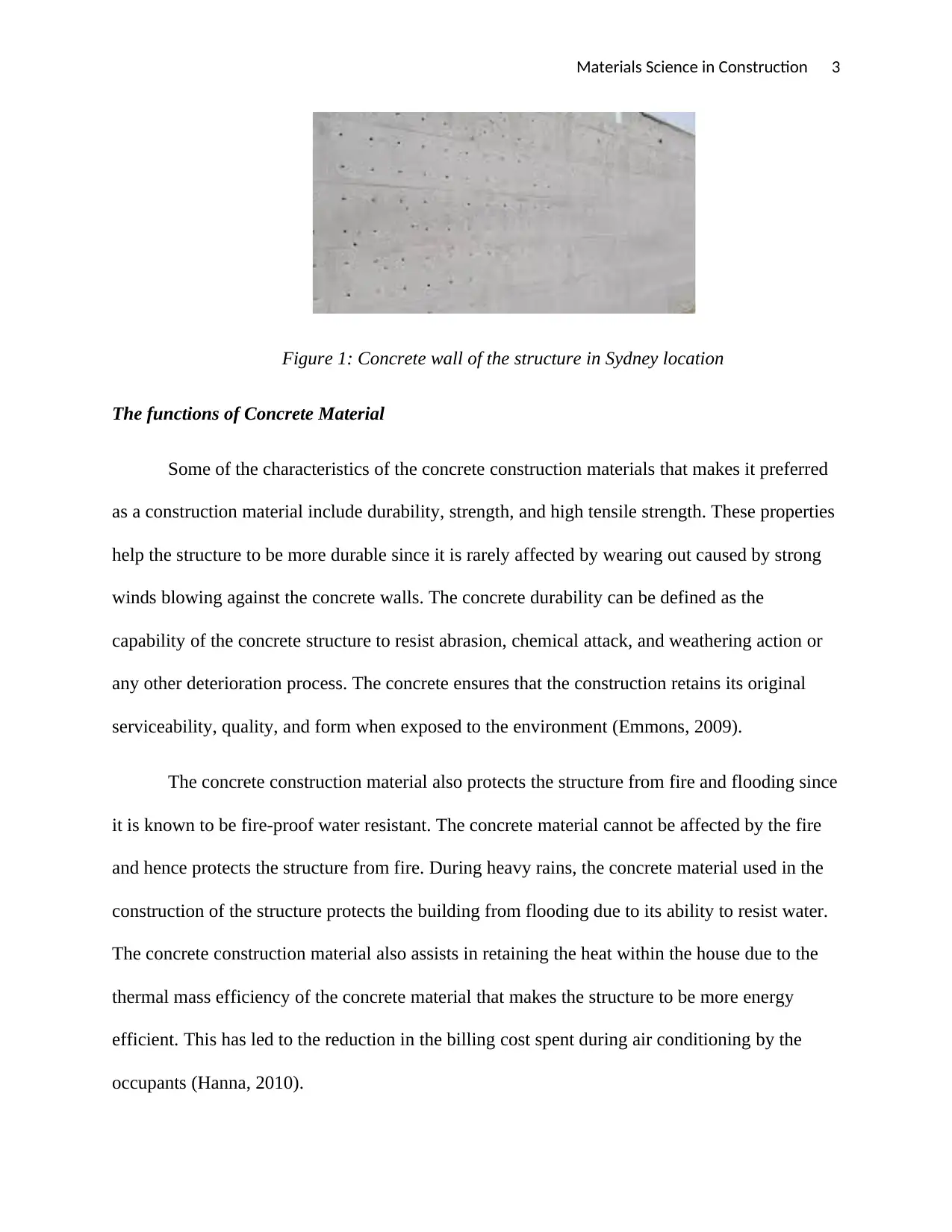
Materials Science in Construction 3
Figure 1: Concrete wall of the structure in Sydney location
The functions of Concrete Material
Some of the characteristics of the concrete construction materials that makes it preferred
as a construction material include durability, strength, and high tensile strength. These properties
help the structure to be more durable since it is rarely affected by wearing out caused by strong
winds blowing against the concrete walls. The concrete durability can be defined as the
capability of the concrete structure to resist abrasion, chemical attack, and weathering action or
any other deterioration process. The concrete ensures that the construction retains its original
serviceability, quality, and form when exposed to the environment (Emmons, 2009).
The concrete construction material also protects the structure from fire and flooding since
it is known to be fire-proof water resistant. The concrete material cannot be affected by the fire
and hence protects the structure from fire. During heavy rains, the concrete material used in the
construction of the structure protects the building from flooding due to its ability to resist water.
The concrete construction material also assists in retaining the heat within the house due to the
thermal mass efficiency of the concrete material that makes the structure to be more energy
efficient. This has led to the reduction in the billing cost spent during air conditioning by the
occupants (Hanna, 2010).
Figure 1: Concrete wall of the structure in Sydney location
The functions of Concrete Material
Some of the characteristics of the concrete construction materials that makes it preferred
as a construction material include durability, strength, and high tensile strength. These properties
help the structure to be more durable since it is rarely affected by wearing out caused by strong
winds blowing against the concrete walls. The concrete durability can be defined as the
capability of the concrete structure to resist abrasion, chemical attack, and weathering action or
any other deterioration process. The concrete ensures that the construction retains its original
serviceability, quality, and form when exposed to the environment (Emmons, 2009).
The concrete construction material also protects the structure from fire and flooding since
it is known to be fire-proof water resistant. The concrete material cannot be affected by the fire
and hence protects the structure from fire. During heavy rains, the concrete material used in the
construction of the structure protects the building from flooding due to its ability to resist water.
The concrete construction material also assists in retaining the heat within the house due to the
thermal mass efficiency of the concrete material that makes the structure to be more energy
efficient. This has led to the reduction in the billing cost spent during air conditioning by the
occupants (Hanna, 2010).
⊘ This is a preview!⊘
Do you want full access?
Subscribe today to unlock all pages.

Trusted by 1+ million students worldwide
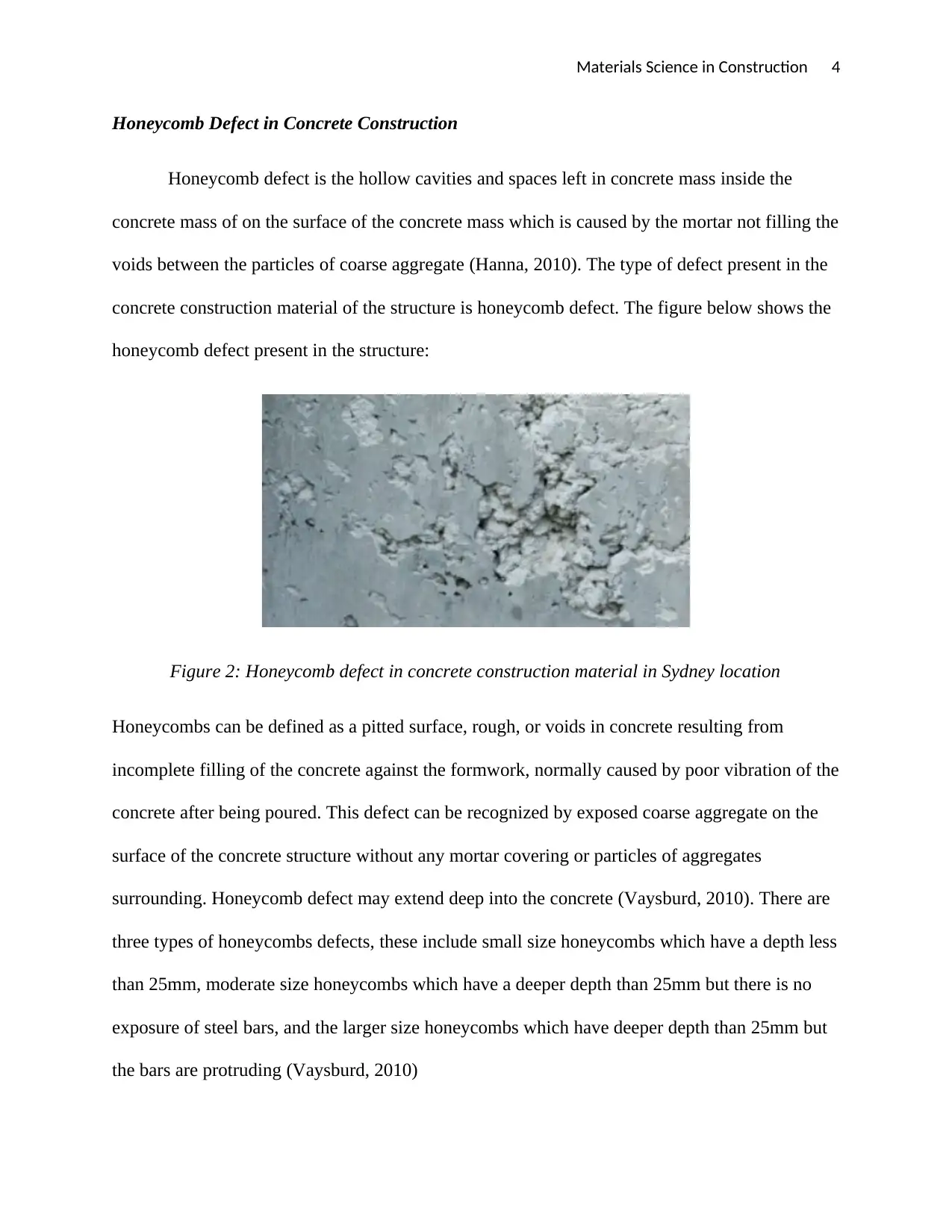
Materials Science in Construction 4
Honeycomb Defect in Concrete Construction
Honeycomb defect is the hollow cavities and spaces left in concrete mass inside the
concrete mass of on the surface of the concrete mass which is caused by the mortar not filling the
voids between the particles of coarse aggregate (Hanna, 2010). The type of defect present in the
concrete construction material of the structure is honeycomb defect. The figure below shows the
honeycomb defect present in the structure:
Figure 2: Honeycomb defect in concrete construction material in Sydney location
Honeycombs can be defined as a pitted surface, rough, or voids in concrete resulting from
incomplete filling of the concrete against the formwork, normally caused by poor vibration of the
concrete after being poured. This defect can be recognized by exposed coarse aggregate on the
surface of the concrete structure without any mortar covering or particles of aggregates
surrounding. Honeycomb defect may extend deep into the concrete (Vaysburd, 2010). There are
three types of honeycombs defects, these include small size honeycombs which have a depth less
than 25mm, moderate size honeycombs which have a deeper depth than 25mm but there is no
exposure of steel bars, and the larger size honeycombs which have deeper depth than 25mm but
the bars are protruding (Vaysburd, 2010)
Honeycomb Defect in Concrete Construction
Honeycomb defect is the hollow cavities and spaces left in concrete mass inside the
concrete mass of on the surface of the concrete mass which is caused by the mortar not filling the
voids between the particles of coarse aggregate (Hanna, 2010). The type of defect present in the
concrete construction material of the structure is honeycomb defect. The figure below shows the
honeycomb defect present in the structure:
Figure 2: Honeycomb defect in concrete construction material in Sydney location
Honeycombs can be defined as a pitted surface, rough, or voids in concrete resulting from
incomplete filling of the concrete against the formwork, normally caused by poor vibration of the
concrete after being poured. This defect can be recognized by exposed coarse aggregate on the
surface of the concrete structure without any mortar covering or particles of aggregates
surrounding. Honeycomb defect may extend deep into the concrete (Vaysburd, 2010). There are
three types of honeycombs defects, these include small size honeycombs which have a depth less
than 25mm, moderate size honeycombs which have a deeper depth than 25mm but there is no
exposure of steel bars, and the larger size honeycombs which have deeper depth than 25mm but
the bars are protruding (Vaysburd, 2010)
Paraphrase This Document
Need a fresh take? Get an instant paraphrase of this document with our AI Paraphraser
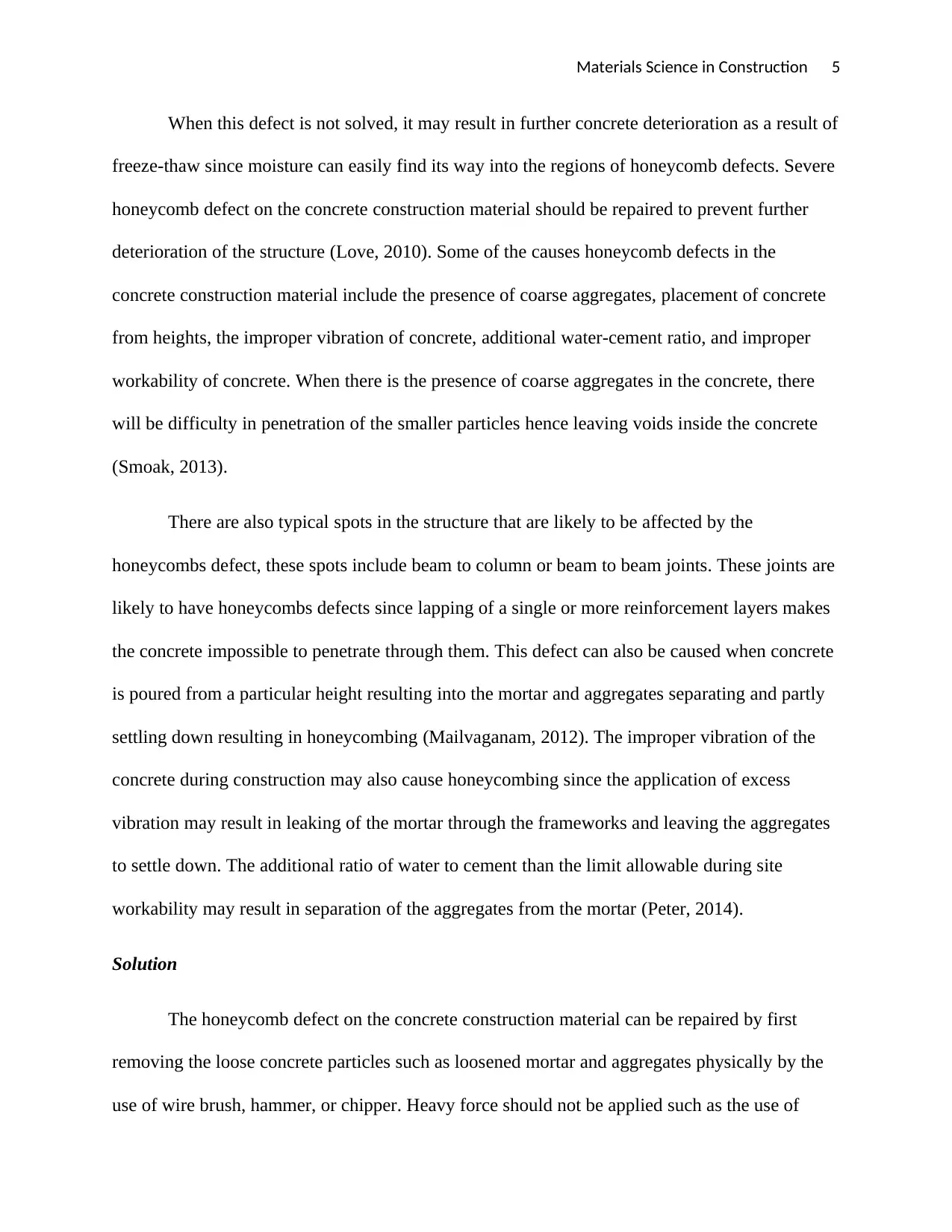
Materials Science in Construction 5
When this defect is not solved, it may result in further concrete deterioration as a result of
freeze-thaw since moisture can easily find its way into the regions of honeycomb defects. Severe
honeycomb defect on the concrete construction material should be repaired to prevent further
deterioration of the structure (Love, 2010). Some of the causes honeycomb defects in the
concrete construction material include the presence of coarse aggregates, placement of concrete
from heights, the improper vibration of concrete, additional water-cement ratio, and improper
workability of concrete. When there is the presence of coarse aggregates in the concrete, there
will be difficulty in penetration of the smaller particles hence leaving voids inside the concrete
(Smoak, 2013).
There are also typical spots in the structure that are likely to be affected by the
honeycombs defect, these spots include beam to column or beam to beam joints. These joints are
likely to have honeycombs defects since lapping of a single or more reinforcement layers makes
the concrete impossible to penetrate through them. This defect can also be caused when concrete
is poured from a particular height resulting into the mortar and aggregates separating and partly
settling down resulting in honeycombing (Mailvaganam, 2012). The improper vibration of the
concrete during construction may also cause honeycombing since the application of excess
vibration may result in leaking of the mortar through the frameworks and leaving the aggregates
to settle down. The additional ratio of water to cement than the limit allowable during site
workability may result in separation of the aggregates from the mortar (Peter, 2014).
Solution
The honeycomb defect on the concrete construction material can be repaired by first
removing the loose concrete particles such as loosened mortar and aggregates physically by the
use of wire brush, hammer, or chipper. Heavy force should not be applied such as the use of
When this defect is not solved, it may result in further concrete deterioration as a result of
freeze-thaw since moisture can easily find its way into the regions of honeycomb defects. Severe
honeycomb defect on the concrete construction material should be repaired to prevent further
deterioration of the structure (Love, 2010). Some of the causes honeycomb defects in the
concrete construction material include the presence of coarse aggregates, placement of concrete
from heights, the improper vibration of concrete, additional water-cement ratio, and improper
workability of concrete. When there is the presence of coarse aggregates in the concrete, there
will be difficulty in penetration of the smaller particles hence leaving voids inside the concrete
(Smoak, 2013).
There are also typical spots in the structure that are likely to be affected by the
honeycombs defect, these spots include beam to column or beam to beam joints. These joints are
likely to have honeycombs defects since lapping of a single or more reinforcement layers makes
the concrete impossible to penetrate through them. This defect can also be caused when concrete
is poured from a particular height resulting into the mortar and aggregates separating and partly
settling down resulting in honeycombing (Mailvaganam, 2012). The improper vibration of the
concrete during construction may also cause honeycombing since the application of excess
vibration may result in leaking of the mortar through the frameworks and leaving the aggregates
to settle down. The additional ratio of water to cement than the limit allowable during site
workability may result in separation of the aggregates from the mortar (Peter, 2014).
Solution
The honeycomb defect on the concrete construction material can be repaired by first
removing the loose concrete particles such as loosened mortar and aggregates physically by the
use of wire brush, hammer, or chipper. Heavy force should not be applied such as the use of
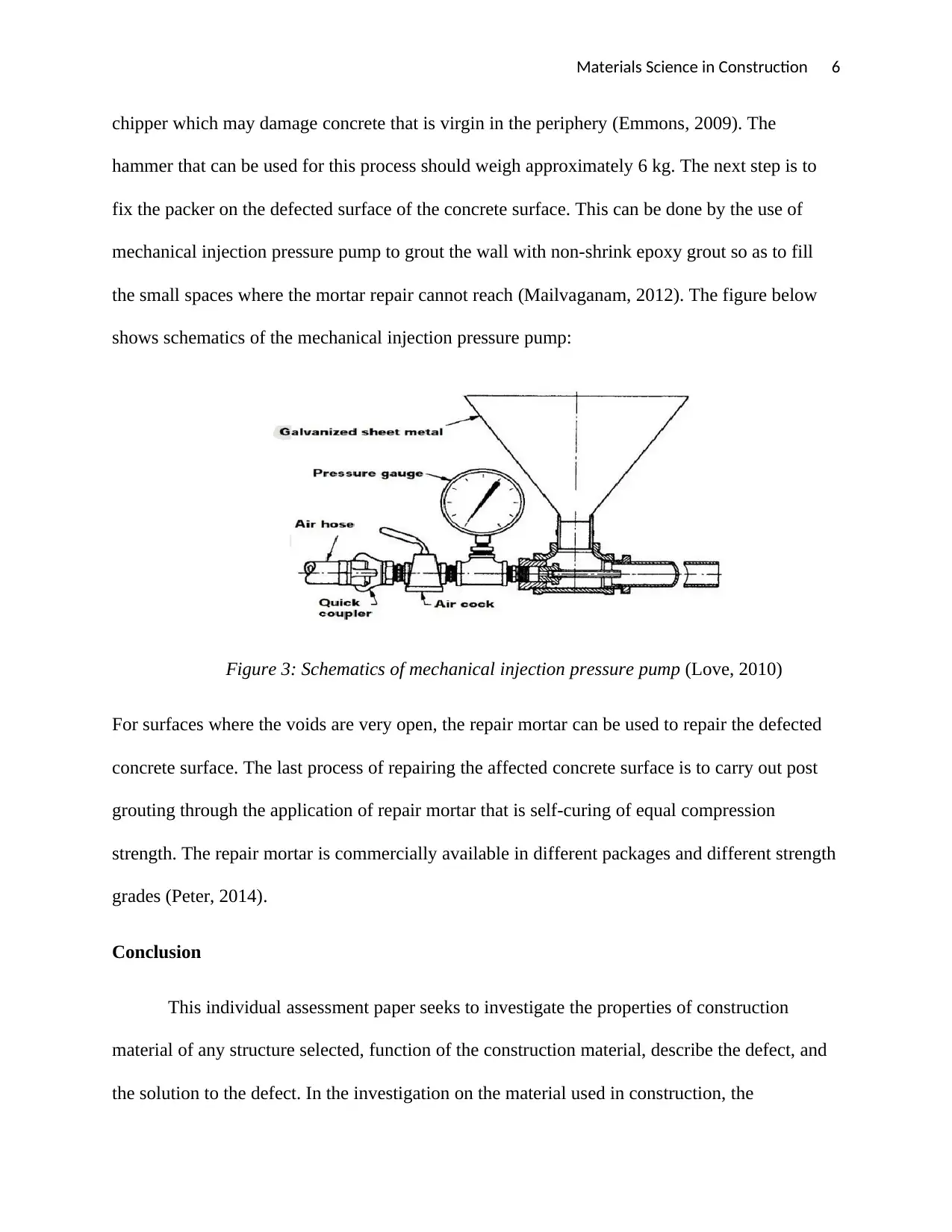
Materials Science in Construction 6
chipper which may damage concrete that is virgin in the periphery (Emmons, 2009). The
hammer that can be used for this process should weigh approximately 6 kg. The next step is to
fix the packer on the defected surface of the concrete surface. This can be done by the use of
mechanical injection pressure pump to grout the wall with non-shrink epoxy grout so as to fill
the small spaces where the mortar repair cannot reach (Mailvaganam, 2012). The figure below
shows schematics of the mechanical injection pressure pump:
Figure 3: Schematics of mechanical injection pressure pump (Love, 2010)
For surfaces where the voids are very open, the repair mortar can be used to repair the defected
concrete surface. The last process of repairing the affected concrete surface is to carry out post
grouting through the application of repair mortar that is self-curing of equal compression
strength. The repair mortar is commercially available in different packages and different strength
grades (Peter, 2014).
Conclusion
This individual assessment paper seeks to investigate the properties of construction
material of any structure selected, function of the construction material, describe the defect, and
the solution to the defect. In the investigation on the material used in construction, the
chipper which may damage concrete that is virgin in the periphery (Emmons, 2009). The
hammer that can be used for this process should weigh approximately 6 kg. The next step is to
fix the packer on the defected surface of the concrete surface. This can be done by the use of
mechanical injection pressure pump to grout the wall with non-shrink epoxy grout so as to fill
the small spaces where the mortar repair cannot reach (Mailvaganam, 2012). The figure below
shows schematics of the mechanical injection pressure pump:
Figure 3: Schematics of mechanical injection pressure pump (Love, 2010)
For surfaces where the voids are very open, the repair mortar can be used to repair the defected
concrete surface. The last process of repairing the affected concrete surface is to carry out post
grouting through the application of repair mortar that is self-curing of equal compression
strength. The repair mortar is commercially available in different packages and different strength
grades (Peter, 2014).
Conclusion
This individual assessment paper seeks to investigate the properties of construction
material of any structure selected, function of the construction material, describe the defect, and
the solution to the defect. In the investigation on the material used in construction, the
⊘ This is a preview!⊘
Do you want full access?
Subscribe today to unlock all pages.

Trusted by 1+ million students worldwide
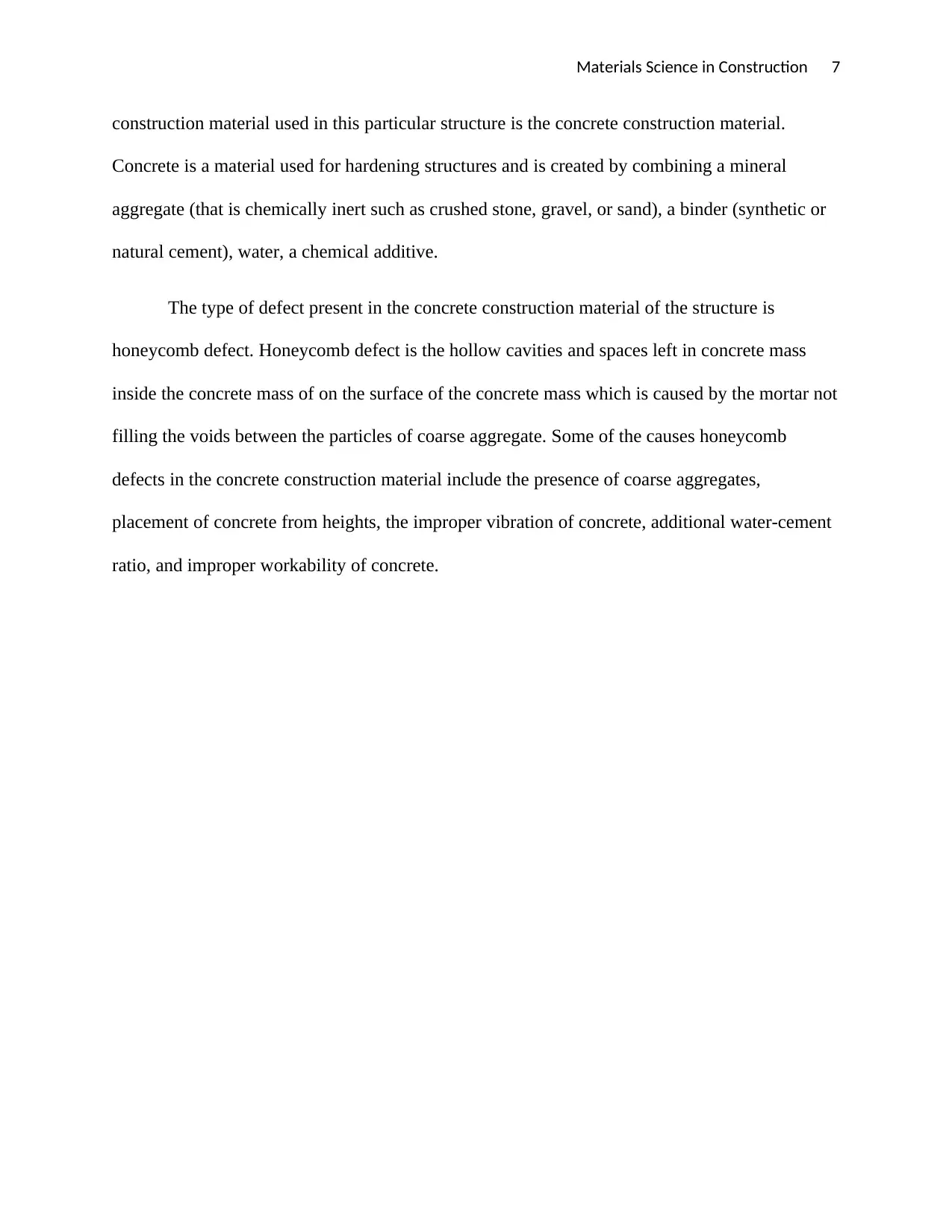
Materials Science in Construction 7
construction material used in this particular structure is the concrete construction material.
Concrete is a material used for hardening structures and is created by combining a mineral
aggregate (that is chemically inert such as crushed stone, gravel, or sand), a binder (synthetic or
natural cement), water, a chemical additive.
The type of defect present in the concrete construction material of the structure is
honeycomb defect. Honeycomb defect is the hollow cavities and spaces left in concrete mass
inside the concrete mass of on the surface of the concrete mass which is caused by the mortar not
filling the voids between the particles of coarse aggregate. Some of the causes honeycomb
defects in the concrete construction material include the presence of coarse aggregates,
placement of concrete from heights, the improper vibration of concrete, additional water-cement
ratio, and improper workability of concrete.
construction material used in this particular structure is the concrete construction material.
Concrete is a material used for hardening structures and is created by combining a mineral
aggregate (that is chemically inert such as crushed stone, gravel, or sand), a binder (synthetic or
natural cement), water, a chemical additive.
The type of defect present in the concrete construction material of the structure is
honeycomb defect. Honeycomb defect is the hollow cavities and spaces left in concrete mass
inside the concrete mass of on the surface of the concrete mass which is caused by the mortar not
filling the voids between the particles of coarse aggregate. Some of the causes honeycomb
defects in the concrete construction material include the presence of coarse aggregates,
placement of concrete from heights, the improper vibration of concrete, additional water-cement
ratio, and improper workability of concrete.
Paraphrase This Document
Need a fresh take? Get an instant paraphrase of this document with our AI Paraphraser
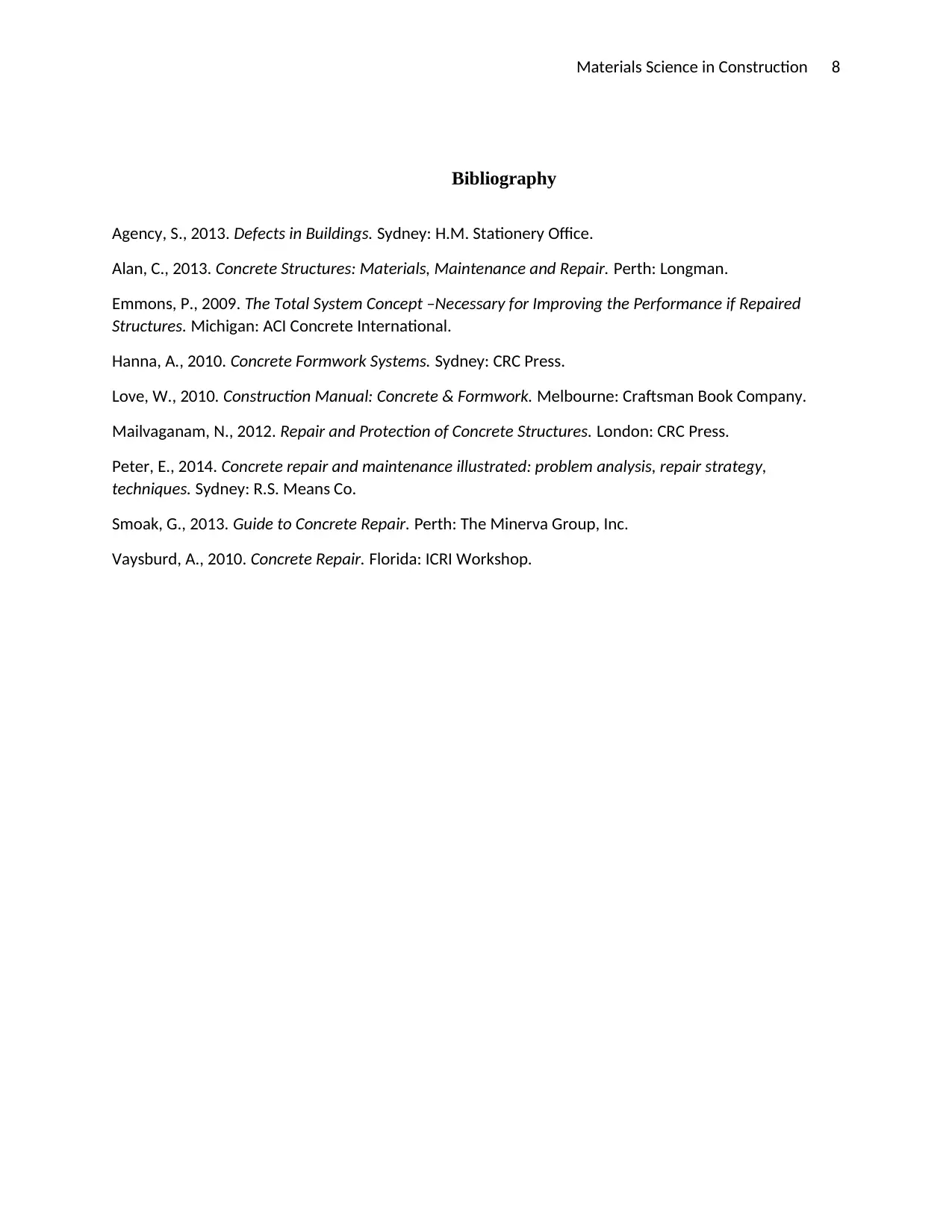
Materials Science in Construction 8
Bibliography
Agency, S., 2013. Defects in Buildings. Sydney: H.M. Stationery Office.
Alan, C., 2013. Concrete Structures: Materials, Maintenance and Repair. Perth: Longman.
Emmons, P., 2009. The Total System Concept –Necessary for Improving the Performance if Repaired
Structures. Michigan: ACI Concrete International.
Hanna, A., 2010. Concrete Formwork Systems. Sydney: CRC Press.
Love, W., 2010. Construction Manual: Concrete & Formwork. Melbourne: Craftsman Book Company.
Mailvaganam, N., 2012. Repair and Protection of Concrete Structures. London: CRC Press.
Peter, E., 2014. Concrete repair and maintenance illustrated: problem analysis, repair strategy,
techniques. Sydney: R.S. Means Co.
Smoak, G., 2013. Guide to Concrete Repair. Perth: The Minerva Group, Inc.
Vaysburd, A., 2010. Concrete Repair. Florida: ICRI Workshop.
Bibliography
Agency, S., 2013. Defects in Buildings. Sydney: H.M. Stationery Office.
Alan, C., 2013. Concrete Structures: Materials, Maintenance and Repair. Perth: Longman.
Emmons, P., 2009. The Total System Concept –Necessary for Improving the Performance if Repaired
Structures. Michigan: ACI Concrete International.
Hanna, A., 2010. Concrete Formwork Systems. Sydney: CRC Press.
Love, W., 2010. Construction Manual: Concrete & Formwork. Melbourne: Craftsman Book Company.
Mailvaganam, N., 2012. Repair and Protection of Concrete Structures. London: CRC Press.
Peter, E., 2014. Concrete repair and maintenance illustrated: problem analysis, repair strategy,
techniques. Sydney: R.S. Means Co.
Smoak, G., 2013. Guide to Concrete Repair. Perth: The Minerva Group, Inc.
Vaysburd, A., 2010. Concrete Repair. Florida: ICRI Workshop.
1 out of 8
Related Documents
Your All-in-One AI-Powered Toolkit for Academic Success.
+13062052269
info@desklib.com
Available 24*7 on WhatsApp / Email
![[object Object]](/_next/static/media/star-bottom.7253800d.svg)
Unlock your academic potential
Copyright © 2020–2025 A2Z Services. All Rights Reserved. Developed and managed by ZUCOL.





